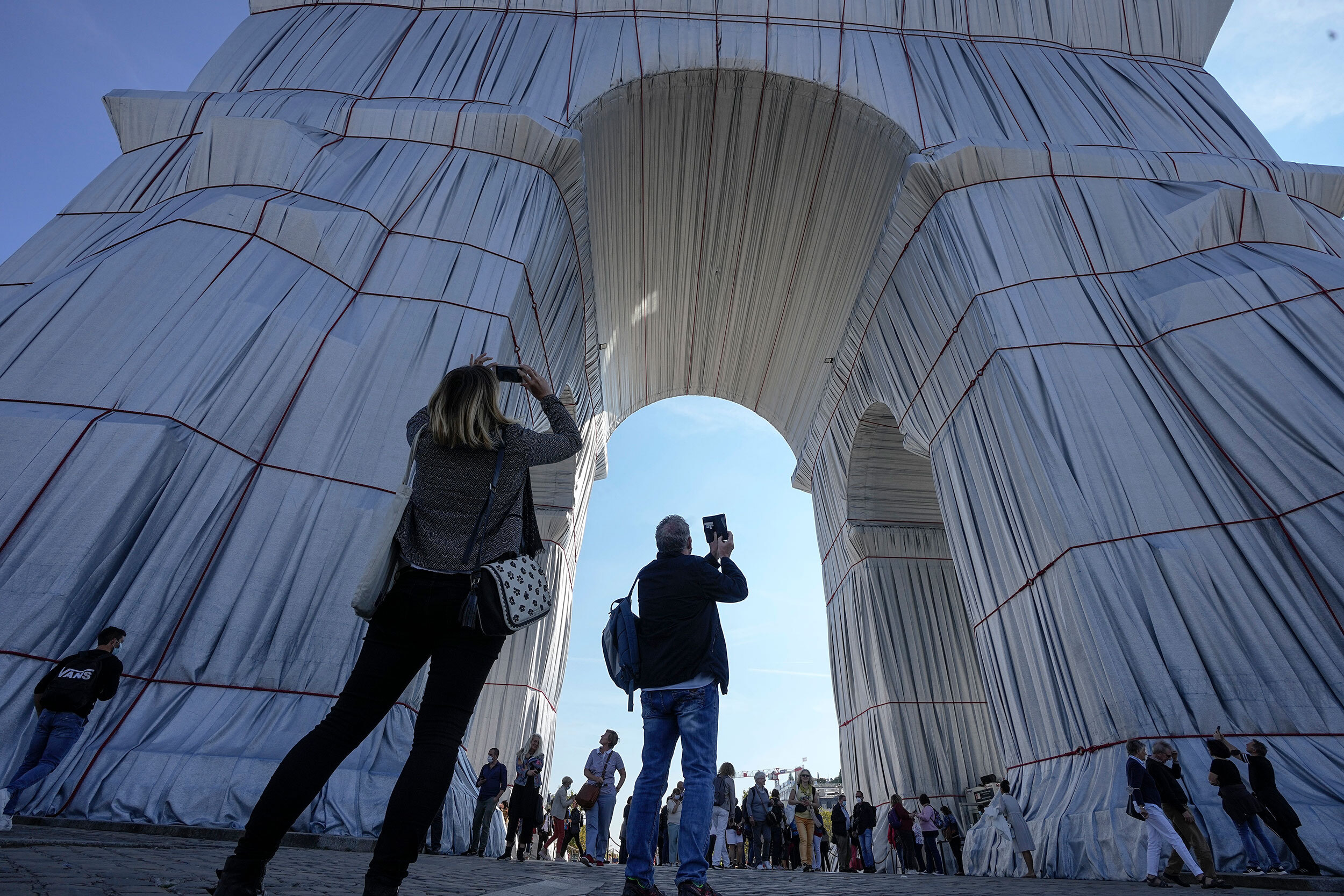
Close to 270,000 square feet of recyclable polypropylene fabric and roughly 10,000 feet of red rope were used to wrap the Arc de Triomphe in Paris.
AP Photo/Michel Euler
Something darker than awe
Wrapping your mind around massive artworks of Christo and Jeanne-Claude is a complex process, psychologist says
They stretched an 18-foot-high swath of nylon across a 24.5-mile expanse of rolling hills in Northern California, flew saffron-colored vinyl panels from 7,503 gates along 23 miles of walkways in Central Park, and erected 3,100 giant blue-and-gold umbrellas in two valleys, one in China, the other in the U.S.
But the late husband-and-wife artists Christo and Jeanne-Claude were best known for wrapping things — big things — islands, bridges, buildings, and most recently an iconic Paris landmark. Through Oct. 3, the Arc de Triomphe, the massive Napoleonic arch built to honor the victories of the French army, will be covered with close to 270,000 square feet of shimmering, silvery blue recyclable polypropylene fabric and roughly 10,000 feet of red rope. Those unable to visit can watch a livestream of the installation, a posthumous project overseen by Christo’s nephew Vladimir Yavachev. (Jeanne-Claude died in November 2009, Christo in May 2020.)
In a conversation with the Gazette, Ellen Winner — a professor of psychology at Boston College, principal investigator at the Harvard Graduate School of Education’s research center Project Zero, and author of “How Art Works: A Psychological Exploration” — discussed how the mind processes large-scale art like Christo and Jeanne-Claude’s. The interview was edited for clarity and length.
Q&A
Ellen Winner
GAZETTE: What is happening in the mind of a viewer of the wrapped Arc de Triomphe?
WINNER: First of all, it shocks. Part of the reason it’s so shocking is the enormous scale. That scale brings you up short. And then there’s the contrast of this hard stone artifact and the soft cloth around it, where you can see the shape, but not any real details, so, it makes you wonder what’s underneath. It also makes you notice the shape and scale of the Arc de Triomphe in a way that you might not have before. Christo’s teasing you in a way, because you know what’s underneath, but he gets you to think about what is there that you hadn’t noticed before.
GAZETTE: What moves people about this type of work?
WINNER: My guess is that Christo’s works inspire a feeling of awe — awe at the enormous scale, awe at sensing the massive amount of physical labor that had to go into this kind of project, and perhaps even a kind of eerie uncanny feeling we get from seeing soft, moving cloth around a hard, static object, or seeing cloth, which is fabricated, wrapped around an island, which is wholly unfabricated. The contrasts in the works are shocking. But I don’t think we would have any of these feelings if it were not for the huge scale. We never ordinarily see cloth on such a scale, and that makes the art very surprising.
GAZETTE: Can you say more about the emotional responses people have to art?
“Christo’s teasing you in a way, because you know what’s underneath, but he gets you to think about what is there that you hadn’t noticed before,” said psychologist Ellen Winner.
Jon Chase/Harvard file photo

WINNER: The findings from studies by some psychologists show that when people feel profoundly moved by a work of art, they have a mixture of positive and negative emotions. They never just feel positive emotions. It always has something to do with sadness, or shock — fear — as well as the pleasure in the beauty. Something that is considered to be a truly happy work of art, or purely happy piece of poetry, is typically considered to be less moving. It’s also usually considered less great. So where does that leave us with Christo — what are the positive and negative emotions? Well, as I mentioned, there’s certainly a feeling of the scale and that’s a positive emotion. In terms of the negative emotion, I can’t say for sure, but one guess might be there could be some kind of negative feeling associated with taking a beautiful piece of architecture and covering it up.
GAZETTE: In “How Art Works,” you wrote that “people see more in abstract art than they think they see,” and that they can see “the mind behind the work.” Do you think this is happening with the Arc de Triomphe?
WINNER: This is a work of conceptual art, and all art, but especially conceptual art, prompts us to think about the mind of the artist. We can’t help but wonder why Christo did this, what he was trying to make us think and feel. One really cannot understand conceptual art without knowing what the artists say they are doing. Take a rather extreme example: Ai Weiwei’s installation “Straight” is made out of 150 steel bars that had been mangled in an earthquake that killed thousands of children in a school building made of substandard cement. Ai Weiwei straightened the rods and laid them on the ground as a commemoration and a protest. There is no way to make sense of this work without knowing the context.
GAZETTE: Do you like Christo’s work?
WINNER: I find it quite awe-inspiring. I’ve never seen any of it in person, only in photos and videos. I think seeing the Arc de Triomphe in person must be overwhelming — a bit like looking at the pyramids because of the enormity of the scale and effort.




